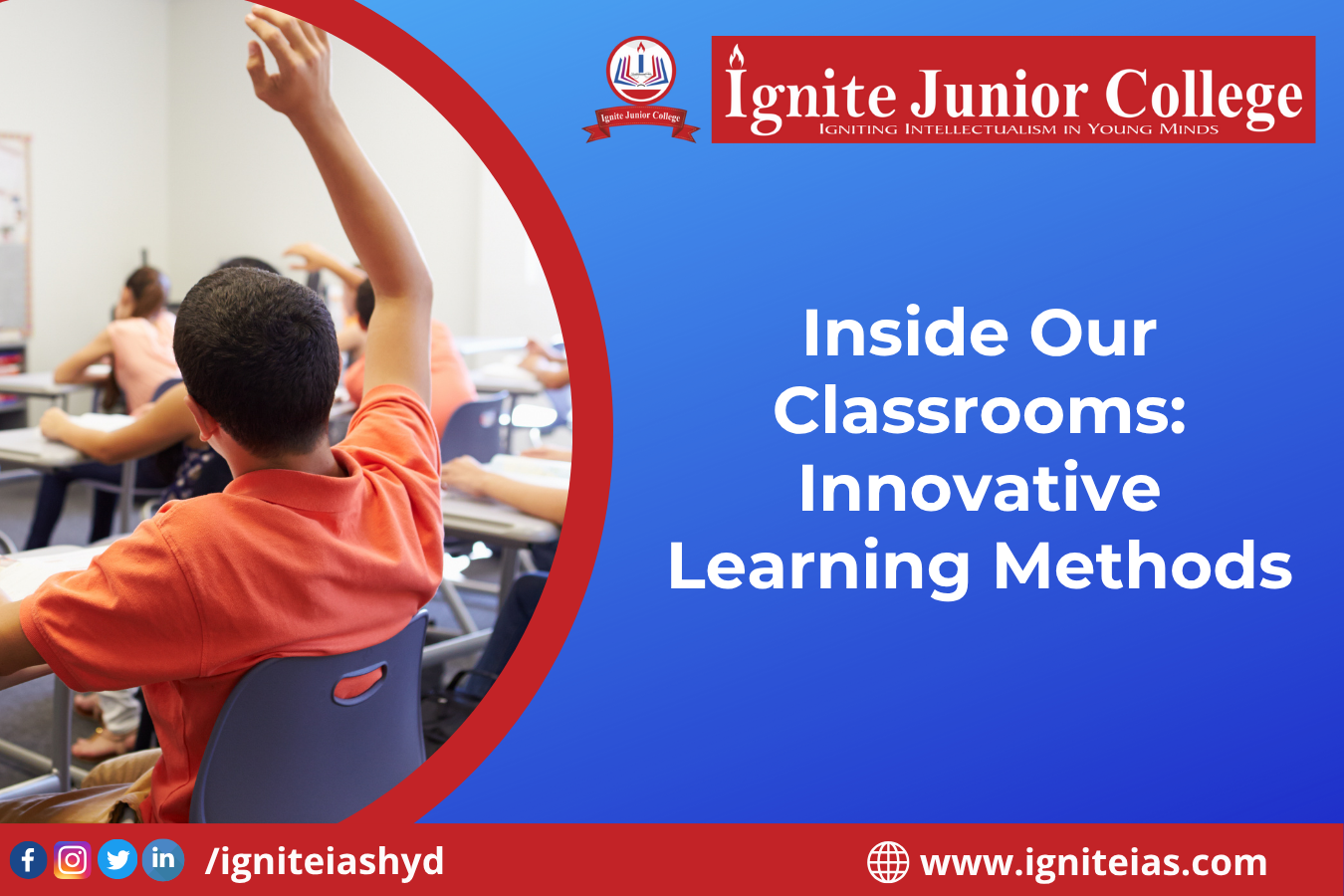Introduction
Remember the days when classrooms meant blackboards, chalk, and one-sided lectures? That era is fading fast. Today, education isn’t just about memorizing facts, it’s about making learning exciting, relevant, and practical.
At Ignite Junior College, known as the Best Junior College in Hyderabad along with Competitive Exams preparation, we believe that learning should spark curiosity and inspire students to go beyond textbooks. Our classrooms are more than four walls—they’re labs of innovation, collaboration, and creativity.
Let’s take you on a journey inside our classrooms, where learning methods are evolving and students are thriving.
Table of Contents
| Sr# | Headings |
|---|---|
| 1 | The Shift from Traditional to Innovative Learning |
| 2 | Active Learning: Making Students the Heroes |
| 3 | Smart Classrooms with Digital Integration |
| 4 | Project-Based Learning (PBL) in Practice |
| 5 | Flipped Classrooms: Homework Meets the Lecture |
| 6 | Experiential Learning Through Real-Life Activities |
| 7 | Mind Mapping and Visual Learning Tools |
| 8 | Peer Learning: Students Teaching Students |
| 9 | Interdisciplinary Learning at Ignite |
| 10 | Case Studies and Problem-Solving Sessions |
| 11 | Learning Beyond the Classroom Walls |
| 12 | Communication-Driven Classroom Engagement |
| 13 | Role of Teachers as Facilitators, Not Just Instructors |
| 14 | Integrating Competitive Exam Preparation with Innovation |
| 15 | How Innovation Makes Learning More Meaningful |
1. The Shift from Traditional to Innovative Learning
Gone are the days when teachers talked and students just listened. At Ignite, the shift is clear—we focus on student-centered learning. Our goal isn’t to teach everything—it’s to help students learn how to learn.
We’ve replaced boring lectures with engaging, interactive, and collaborative methods that make every topic a discovery.
2. Active Learning: Making Students the Heroes
In traditional methods, students are passive listeners. In active learning, they participate, question, discuss, and apply.
We use:
- Group discussions
- Case studies
- Real-time quizzes
- Brainstorming sessions
This method not only improves understanding but also builds confidence and critical thinking.
3. Smart Classrooms with Digital Integration
Imagine learning physics with interactive 3D simulations or revising biology through animated content.
At Ignite, every classroom is equipped with smart boards, projectors, and digital tools. Our faculty uses:
- Educational videos
- Online assessments
- Real-time feedback systems
This tech-driven approach makes complex topics simple, visual, and memorable.
4. Project-Based Learning (PBL) in Practice
We believe learning should go beyond theory. That’s why we use Project-Based Learning, where students solve real-world problems as part of their academic journey.
Whether it’s:
- Creating a business plan in economics
- Building a working model in physics
- Analyzing social issues in civics
PBL encourages research, teamwork, and practical application.
5. Flipped Classrooms: Homework Meets the Lecture
In a flipped classroom, students watch lectures or read materials before class, and use classroom time to discuss, analyze, and solve problems.
This way:
- Students come prepared
- Teachers become facilitators
- Sessions become more productive and engaging
It’s one of our most effective tools for personalized learning.
6. Experiential Learning Through Real-Life Activities
Textbooks explain, but experiences teach. At Ignite, we give students hands-on experiences through:
- Science experiments
- Mock parliaments
- Field visits
- Entrepreneurial events
These experiences make learning fun, concrete, and unforgettable.
7. Mind Mapping and Visual Learning Tools
We use mind maps, infographics, and visual aids to help students see the big picture. Instead of long notes, students create visual summaries to:
- Connect ideas
- Organize concepts
- Remember better
It’s like turning pages of text into colorful memory maps.
8. Peer Learning: Students Teaching Students
Sometimes, a friend explains a concept better than a teacher. At Ignite, we promote peer learning, where students:
- Discuss concepts in groups
- Explain topics to one another
- Work together on learning modules
It improves collaboration, communication, and clarity.
9. Interdisciplinary Learning at Ignite
Subjects are not isolated in real life—why should they be in class? We use interdisciplinary learning, where students connect concepts across subjects.
Example:
A project combining math, physics, and economics to analyze the cost-efficiency of solar energy.
It prepares students for integrated thinking—essential for success in modern careers.
10. Case Studies and Problem-Solving Sessions
Instead of just reading theories, students analyze real-world scenarios through case studies. Whether it’s a business challenge or a historical dilemma, students:
- Identify issues
- Suggest solutions
- Justify their choices
This hones their analytical and decision-making skills, essential for competitive exams.
11. Learning Beyond the Classroom Walls
Not all learning happens indoors. At Ignite, we encourage learning through:
- Industrial visits
- Nature camps
- Social outreach programs
- Guest lectures
These outside-the-box experiences expand horizons and build awareness.
12. Communication-Driven Classroom Engagement
Every class includes time for open discussion, Q&A sessions, and feedback. Communication is not just a skill here—it’s a culture.
Students present:
- Weekly summaries
- Research reports
- Debates and elocution
This practice improves clarity, public speaking, and confidence.
13. Role of Teachers as Facilitators, Not Just Instructors
At Ignite, teachers don’t just teach—they guide, coach, and mentor. Instead of giving answers, they:
- Ask questions
- Encourage exploration
- Support individual learning styles
This mentorship mindset ensures deeper understanding and personal growth.
14. Integrating Competitive Exam Preparation with Innovation
Even as we follow an innovative approach, we never lose sight of our goal—competitive exam success.
We blend:
- Innovative teaching with regular mock tests
- Concept clarity with MCQ practice
- Group learning with individual attention
This fusion makes Ignite the Best Junior College in Hyderabad along with Competitive Exams preparation.
15. How Innovation Makes Learning More Meaningful
The outcome of all this innovation? Students who are:
- Curious, not just compliant
- Skill-ready, not just exam-ready
- Collaborative, not just competitive
Learning becomes a joyful, engaging experience—something that stays with them long after they leave the classroom.
Conclusion
At Ignite Junior College, learning isn’t about surviving the syllabus—it’s about thriving through curiosity. Our classrooms are powered by technology, creativity, collaboration, and care. Every student who walks in doesn’t just get an education—they get a launchpad for life.
In a world where change is the only constant, we don’t just prepare students to keep up. We prepare them to lead. That’s what makes us the Best Junior College in Hyderabad along with Competitive Exams preparation.
Frequently Asked Questions (FAQs)
1. What makes Ignite’s learning methods innovative?
Ignite combines tech-enabled tools, project-based learning, flipped classrooms, and real-world applications to make learning engaging and effective.
2. How do these innovative methods help with competitive exams?
They build conceptual clarity, analytical thinking, and application-based understanding—essential for cracking JEE, NEET, CLAT, and other exams.
3. Are students involved in creating their own learning projects?
Yes! Students regularly take part in collaborative projects that connect classroom knowledge with real-world scenarios.
4. What technologies are used in Ignite classrooms?
Smart boards, digital content, real-time quiz platforms, and interactive apps are part of daily teaching.
5. Do these learning methods benefit average or shy students too?
Absolutely. The focus on peer learning, teacher support, and non-traditional formats helps every type of learner grow and succeed.



